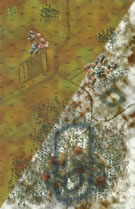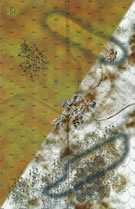| Author |
scrane
|
| Method |
Solo |
| Victor |
Canada |
| Play Date |
2020-08-25 |
| Language |
English |
| Scenario |
MaLB007
|
So this is another meeting engagement with about a battalion of Canadian mechanized infantry supported by 8 platoons (I'm going to think of them as two companies) of tanks trying to clear a road and protect some towns from a battalion of Soviet JS2s with tank riders and two mechanized infantry companies. The Soviets goal is to deny the Canadians their victory conditions.
The Soviet plan was to send the tanks and SMGs up the road to capture the towns that the Canadians were tasked with protecting, while their motor rifle troops defended a cluster of villages at their near end of the road. The Canadians formed two tank/infantry task forces with a company of each, as well as a tactical reserve of the third infantry company. Their plan was to secure the two towns first, one task force each, then push on to clear the road east.
Early turns quickly developed in Canada's favor, with significant Soviet tank losses as they swept around the north and south flanks of the easternmost town. The Canadians lost a few steps of Centurions but quickly sensed the shifting momentum and brought up their reserve to press on to the east up the road. The Soviet tanks, what few remained, fell back with a few straggling SMGs.
In the final three hours the Canadians attacked the Soviet towns from the northwest and southwest. They took a number of casualties from long range MG fire from halftracks and HMG platoons until their tanks picked off every Soviet halftrack. Moving in to set up the final assaults, the Canadians took a few more losses but defeated the Soviet defenders in detail.
Major Canadian victory.
I realize I don't use the APCs in these battles in an historical way. I always have them participate in assaults with the infantry and provide fire support from in among their dismounts, which as I understand it is more of an IFV function. It would be more realistic to have them dismount their charges at maximum MG range and provide support fire or flank protection rather than charging in to the fight, where I tend to use them to soak up X results in combat.
|




 MaLB006
MaLB006 






















